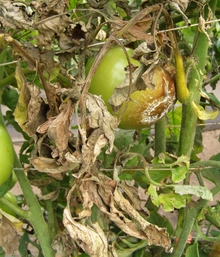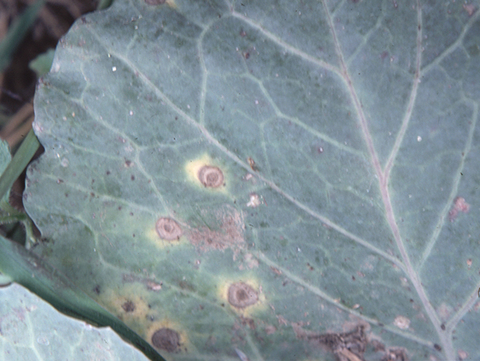Author: Natalie Hoidal, UMN Extension educator, local foods and vegetable crops
This
is the final vegetable update of the season! Thanks to all of you who followed along and shared questions and photos along the way. There is still no sign of a hard frost in the forecast for any part of the state, but many field crops are reaching their final days, and summer high tunnel crops are slowing down from diseases, insects, and other issues. This article includes updates about a couple of important diseases, curing tips, and reminders about soil testing + nitrogen credits.
Crop updates
- Tomatoes and potatoes: Late blight was officially identified in Itasca County this week in a potato field. We've also been hearing reports of it from farms in and around St. Louis County. The bad news: late blight spreads very quickly under cool, wet conditions. Fall weather is great for late blight spread in Minnesota. It's also a water mold and not a true fungus, meaning many fungicides do not control it. Review the Midwest Vegetable Guide for fungicide recommendations. The better news: late blight typically does not overwinter in Minnesota. It can technically overwinter in cull piles, and it can come back in volunteer tomatoes that come from the seeds of infected fruit. If you're seeing late blight on your farm, make sure to bury or incorporate your residues, and pay very close attention to culling volunteer tomatoes and potatoes next year. Read more about the disease here.
 |
| Photo: Michelle Grabowski |
- Pumpkins and squash: I'm seeing a major push on farms across the state this week to harvest all remaining winter squash and cure it for fall. Keep an eye on weather conditions if you are planning to field cure your squash; there's sporadic rain forecasted across the state all week, so indoor curing may be a better bet. One of the most common issues I see in curing set-ups is insufficient airflow. If you're curing inside, make sure to invest in plenty of fans. If you're planning to store squash for more than a few days, review the postharvest handling guide for best practices for storage conditions. Halloween pumpkins remain in the field, and for the most part, they are in great shape this year. We've had low rates of powdery mildew across the state, so pumpkin canopies have remained in-tact and are keeping pumpkins shaded.
- Melons: Every year towards the end of the season I see melons on farmers market stands and in CSA boxes with anthracnose. This year is no exception. Once the fruit is infected, the pathogen spreads rapidly. Even if it just looks like a small spot on the rind, it's usually not worth including it in your CSA or farmers market stand, as the fruit will be rotten beyond the point that your customers want to eat it by the time it reaches them and sits on the counter for more than a few hours.
- Cole crops: I am doing a final push this week to collect Alternaria infected plants. This is part of an effort to map the distribution of the various Alternaria species affecting cole crops across the country to better understand how this disease is evolving and why it's become so much more prevalent in the last couple of years. If you're seeing Alternaria in any of your cole crops and would be willing to spare one leaf from 30 plants, please let me know! I can either come to your farm and collect samples, or I can send you a prepaid box and shipping label.
 |
| Alternaria leaf lesions on cabbage. Photo: Penn State Department of Plant Pathology & Environmental Microbiology Archives , Penn State University, Bugwood.org |
- Sweet corn: While corn earworm trap counts fell again last week, I noticed quite a bit of CEW in sweet corn purchased from multiple farmers markets in the south metro last week. At this point in the season, most growers are doing their final sweet corn harvest, so treatment is likely not worth it. Instead, basic customer education may be the best option for the final crop of sweet corn. In case it's helpful, here's our customer facing handout about worms in sweetcorn.
- Garlic: Growers
in Northern Minnesota can start to think about planting in the next
week or so. Growers in the Southern part of the state should wait about 3
weeks. I'd like to remind everyone of an episode of The Vegetable Beet
we recorded a couple of years ago that provides a deep dive on garlic
production and keeping seed garlic clean / viable: Vegetable Beet: The garlic guru - From clean seed to scaping.
Problems in the field / things to note this week
Fall soil testing and estimating nitrogen credits
As you wrap up field work for the fall, consider getting your soil tested. Our team is available to work with you to understand your soil test results and make management recommendations for the coming year.
| In addition to testing your soil, make sure to take stock of nitrogen credits from this year's practices. If you have a cover crop in the field, take some time to estimate your biomass so that you can figure out how much nitrogen to account for next spring. The following video walks viewers through this process: | ||
Connect with the fruit & vegetable team
If you're seeing interesting things in your fields, need help identifying problems, or just want to share photos, we'd love to hear from you! Growers can reach out directly to me any time at hoida016@umn.edu, and you can submit questions and diagnostic help below.F
Comments
Post a Comment